#the primitive hare
Explore tagged Tumblr posts
Text
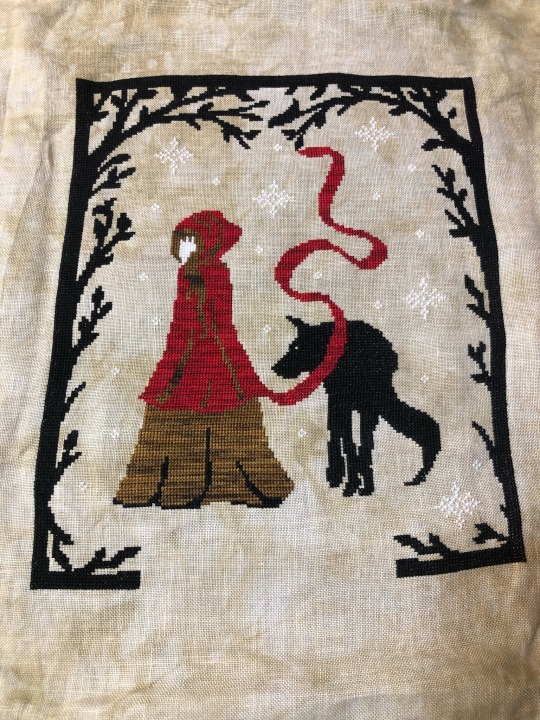
17 notes
·
View notes
Text
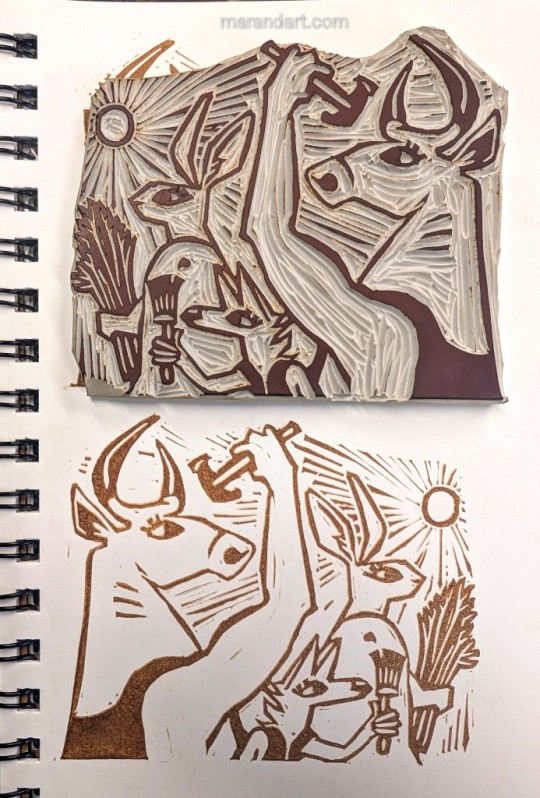
Let's build a future for each other, together!
(New lino coming soon to small prints, cards, and patches ✨)
#art#traditional art#animal art#coyote#hare#bull#teamwork#comrades#printmaking#linoblock#anthropomorphic#primitive wiggles#furry#collectivism
484 notes
·
View notes
Text
it's silly, you know, but you have to try it. may the grapes work.
nanami kento can’t find you when the clock strikes midnight.
there was a ruckus, the release of fireworks outside (who permitted fireworks on school premises?), and cheers of happy new year. itadori toots one of those awful noisemakers. tuna mayos and hugs are exchanged. as planned, nanami maintains a wide berth from gojo, recalling his attempts at a sloppy kiss the previous year. it is a new year; the year of the snake.
but you are nowhere in sight.
why does nanami's belly feel like it's sinking? he smiles, but there is an ache at the centre of his chest. his eyes flick left and right, the festivities unfolding before his eyes. the school had been decorated by the students with the funding of gojo's shiny black card, reds and golds streaming along the walls. stuffed snakes (inumaki's idea) were thrown haphazardly onto the ground. the remnants of the party games from earlier scatter the table-clothed tables.
in your stead, shoko meets nanami's eyes. he nods, giving her a brief hug, sure to grip her just below the shoulder and just above the waist.
"happy new year," he mumbles. shoko smiles. it is politeness exchanged with a colleague and friend, but this is not how he pictured his first interaction of the year (and with whom it was shared).
kento had planned it down to the tee: your favourite wine, no more than two whiskeys, arriving just after you to seemingly rescue you from forcing yourself to yap about things you did not care about (work) with a person you could not care less about (gojo). kento was meticulous, more meticulous than he was at that awful firm he worked at in his early twenties. he had to be. the moment must be perfect. you deserved a wonderful evening. yet, there was a variable he forgot to consider: he couldn't find you.
"ah, nanamin," shoko hums. kento steps back, offering his full attention. there's that awful look on that face of hers, one that dates back more than ten years. the teasing one that reminds kento he is nothing but a lost junior; a silly, unkowing little boy with punk bangs. one that is about to be berated by the scary bobbed girl with a cigarette habit.
a force seizes his lungs, halting their movement. may the berating begin.
"are you looking for someone?" shoko teases. that tone. how grating.
"what gave it away?" no frustration laces kento's voice, only soft desperation.
shoko stacks her hands together and brings them to the side of her face. she tilts her head, her voice sing-song-y. "nothing, just that look of yearning."
kento huffs in frustration. his fists curl in impatience. "where is she, shoko?"
shoko steps to the side, an evil scientist revealing her latest experiment.
when kento sees what is behind her, the world tilts just right.
there you are, under the table, crouched and feral. kento draws back at the sight of you: a monkey, primitive and on the hunt for food. in quick succession, large and luscious green grapes were thrown into your mouth. you were a chipmunk. you stuffed your face full of grapes before you even finished chewing.
you were always a wonder.
shoko's voice is soft, her note of contentment complimenting kento's sudden leisure at the sight of you. "happy new year, nanamin." she pads away.
kento makes a note to gift shoko a red envelope the following day.
there you are; his little star. kento moves, crouches, and parts the red tablecloth.
"you never told me you liked grapes."
your grape-a-thon veers to a halt. absolute horror stills your chewing. you have at least five grapes in your mouth.
kento smiles wide. a rush of warmth washes over him. he could squish you.
this too much attention from a too handsome man. you turn your head away to fend off the rush of blood to your face.
"they're soh exsensiv hare," kento makes out between your voice and the grapes. you chew rigorously, averting your eyes. you hold a hand in between your wobbly mouth and kento’s eyes, falsely creating a front to maintain your dignity. "tha’s why you don seh meh eaving them. gofo saeh he woulv give them tah me."
kento bristles. he would get grapes for you anyday. command or none.
"may i join you?"
you chew a little more in thought, grimacing as you swallow. kento tries hard not to watch your throat, but he can’t resist.
“of course.” you’re sincere. you’ve gone shy. his heart aches. he wants to make you get bashful like this every day.
you scooch over to make room for large and long nanami kento to sit beside you under the table. he’s still wearing those winged shoes you love, but opted for a white knitted sweater that makes you wonder how soft it is. you almost reach for kento’s arm, but you draw back. you’re under the table eating grapes for a reason. you deflate. five more grapes to go.
“you don’t need to be under here with me,” you reassure kento. kento looks like a stuffy that got pounded into a too small toy chest. his neck cranes and his bottom is awkwardly sat in a cross cross. you smile. you want this to last forever.
“i can’t let you be here alone. it’s new years.”
you wring your hands together. you need to eat four more grapes. “thanks, kento.”
you eat your grapes now, but slower. this wasn’t how it was supposed to go. weren’t you supposed to eat all twelve grapes before midnight was over? you glance over at the clock. it’s already too late.
you open your palms: four beautiful green grapes, grown and harvested in japan. when you arrived here, you hadn’t realized fruit was a luxury. fruit is difficult to grow. the majority of land is ill-suited for fruit.
four wasted beautiful grapes.
“that’s enough grapes for tonight.” kento gently takes your hand and rests them on his own. he cups yours, creating a shield. his hands are warm. they’re so much bigger than yours. “you never needed them.”
“yes i did,” you insisted.
kento shakes his head. “no. you don’t need any of that nonsense.”
your frown is deep. your eyes are in a different place. kento cups your hands more firmly now. “you never needed the grapes, darling.”
it’s instinct, the little “no” that forms on the tip of your tongue. it takes a second, another, to realize the precious thing kento had called you.
darling. YOU. darling?!
suddenly, you’re the one gripping kento’s hands. “what did you say?!”
kento shakes his head, patting your hand. “you make this difficult.”
“you! you called me–” you guffaw like a fish when kento nods a tired affirmative, like it was obvious all along. “please don’t lie.”
kento’s eyes turn icy. “i would never lie to you.”
your lips wobble pathetically. you hate this man. he makes you silly and makes your heart beat too fast. he makes you want to turn away and stare all the same because he is too handsome. too kind. so him. and you had always wanted him. but the yearning? you never expected it to be returned.
“nanami kento, were you always on tiktok?”
kento throws back his head and laughs. you stare for too long. you’re allowed to now. “i have three wonderful students.”
the year of the snake will be a wonderful one.
you leave the remaining grapes for gojo. he needed them more than you.
i can't stare at this anymore please take it as it is. happy year of the snake everyone :) hissss
#nanami kento#nanami kento x you#nanami kento x reader#nanami#nanami kento jjk#nanami jjk#nanami fluff#jjk#jjk x you#jjk x reader
2K notes
·
View notes
Text
Here are some AUs that have never seen the light of day and might never will.
First off, Mystical AU. It’s an AU where half of the critters are supernatural elemental all-powerful beings and half are normal. Well somewhat. It’s set somewhere in the old primitive days





Some stuff to know about them.
Daniel Spaniel (Dogday) is the town chief, he’s also a researcher alongside Kylo Doodledoo (Kickin)
Patty Oinks (Picky) is in charge of food and farming, Touille works for her but he also does a lot of chores here or there
Rachel Tellar (Rabie) is the town storyteller and a physician, she’s also secretly a witch but those are frowned upon in their town. She rarely shows outside.
The Birates are a three-man pirate group who help give the town the supplies they need to survive. It consists of Bobby Bearclaw, the brawn. Barrel Elepatch (Bubba) , the brains. And Bibi Wolfeye (Baba) the brutality and also the captain.
The elements are divided by the main ones and the cursed.
The cursed are Murky Gator (Allister), Acid (Icky), and Shadownap (Catnap). While the main elements are Naturepony (Crafty), Stormpoet (Poe), Seashark (Maggie), and Inferno Blaze (Simon).
Aerial Hare (Hoppy) is in neither one, she’s just a much weaker element born from Stormpoet.
Second AU, Ghostlyfeathers.
An AU where Kickin and Poe are ghostbusters, but they’re both scared of everything. Kickin tries to cope by joking around, Poe copes by trying to dismiss everything with science and realism but either way they’re both shitting their pants


Info: Touille was their tech hacker guy who refuses to go into any haunted house because he both hates ghosts and is terrified of them.
Third AU, Suspicious Bubba. Briefly mentioned him before. An AU where Crafty has a feeling her and her friends’ memories are being tampered with, and she suspects Bubba, the one with such amazingly strange intact memories of events he shouldn’t know.

Info: This was going to be an Ask AU but I had a lot going on
Fourth AU, no sketches this time. Papa Gator. It’s similar to Dadphant AU, basically Allister is a dad to 7 children. Oldest from youngest is Simon, Poe, Rabie, Touille, Maggie, Icky, and Baba.
Info: Their last name was Marelin and Papa Gator was 4 years older than Dadphant
Fifth and last AU, Holiday Critters. Someone already made that but I had my own version I never really made
Dogday - Christmas = Merrydog
Catnap - Day of the Dead = Ceasecat
Bubba - New Years Eve = Phas Fireworks
Kickin - April Fools = Playfowl Trickster
Bobby - Valentines Day = Casey Cupidbear
Hoppy - Easter = Easter Chocobun
Crafty - Halloween = Candycorn
Picky - Thanksgiving = Piggy Giftgiver
Info: Playfowl is a pun on Playful
Last AU, no name for it but it was a Hoppyhug AU where Hoppy was a tired cashier and Bobby was a lovesick assassin who fell for her
Info: Hoppy was her target but she couldn’t kill her, therefore went into hiding, all the while stalking Hoppy. I was inspired by a song, “A Female Ninja, But I Want To Love” I think
197 notes
·
View notes
Text
# JB depersonalization (is what I called it in my notes app- it's not rly that but I guess it's what I put down and how I shorthand refer to it now lmao...)
premise: captured by a cult (rogue evil scientists?) & conditioned into an altered mindset? maybe trying to brainwash him or sth, but it's like half-done so they put him in a sort of feral animalistic primitive kind of mindset? can't decide if brainwashing is the end goal or it's just like��� some form of experimenting on something or other (yea this would kind of be inspired by Smoking Remnants)
Bond to Q at some pt (probably later after he's recovered some but not fully): I'm a weapon. wield me, point me, loose me upon your enemies
Bond is captured, collared & cuffed (or mitted), “trained” to follow certain orders, maybe drugged to assist w compliance?
told to submit to being cuffed in place for food, etc
isn't allowed to talk but can make noises
fights at first but complies to keep his energy up, then it does actually kind of become habit cuz that's how conditioning works, even on humans, babyy
given commands and natural consequences- if he fights when getting fed then his hands are restrained & he has to figure it out. If he cooperates, his collar is chained in place but otherwise he can use his hands. If he fights baths/grooming then they leave him be - one time he fights during a shower & they throw him back in wet & miserable.
is taken care of, regularly groomed, gets some rudimentary exercise, and then gets strapped in to a room for experiments (like hypnotizing/conditioning, drugs)
mostly he finds it trite but better than full sense dep ig (or something, maybe sleep deprivation torture)
one time they drug him w something that leaves him so disoriented & sobby- he has vague impressions of being wrapped in a soft warm blanket and someone sitting with him & stroking him, gentling him down until he dozed off.
(?)Sometimes they do throw him in sensory dep, but they tell him exactly what they plan to do and for how long. If he fights the experiments he gets punishments, which he is explicitly told are punishments. bland, unpleasant monotonous food. sensory dep punishments (timeout) - which is a different experience than the sensory dep experiments. Maybe restrained in a soundproof blacked out room for punishments (or like a padded chest?)? brightly lit but ambient/back so he can't damage his vision, active soundproofing but with possible words just on the edge of intelligible. not fully married to this concept, pure spitballing on this
trainer is a woman, maybe? they have him kill a guy or maybe several. tell him he will be rewarded if he kills him, lets him loose in a room w the guy, the other guy has a weapon (but is still no match for a half-feral Bond).
maybe several months in Q is captured as well (mostly I want to get him there somehow so he knows JB's commands and Bond gets familiarized with him lol. Maybe Q kept looking for Bond on the downlow & either he hared off to chase a lead or they tracked him back & caught him out somehow. anyway they bring him in and see Bond responding to his presence and decide to see if using Q can push their experiments further), told to handle him or else JB would be punished. they have to prove it to him (i.e. he refuses, so they punish Bond), but then he complies. JB doesn't seem cognizant of him but has some seeds of recognition- that helps establish the bond. tries to get unruly but they injure Q nonlethally to get JB protective and keep him in line (with further threats to Q). Maybe they have Q fitted with some kind of shock collar too?
takes a week or 2(?) for mi6 to show up and clear house, by that point Q knows his commands & is also the only one who can handle him after all the bad guys are taken out. keep JB sedated during transport, restrained at first but it was causing him distress so they moved them into the same room together, Q convinces JB to stay put in bed for the time being. JB staring at the staff with cold blank almost unblinking eyes, like a wolf's stare. is still nonverbal at first and very guarded. very protective of Q but also follows his commands if like Q tells him to comply w medical staff, stay put if Q needs to debrief or whatever, etc.
(lmao imagine you are a MI6 security personnel approaching Q shortly after they are rescued and maybe are in medical or sth, and you need to get Q or *handwaves* something. anyway- you are this guy, you are approaching the Quartermaster, and then a hostile 00 appears from who knows where to firmly intercept and also start approaching you hostilely, all the while emitting a sound from deep in his throat that can only be termed growling. And then the Quartermaster goes (sharply) Bond! Leave it! Heel! and he does that- falls silent, retreats to the Quartermaster's side, though continues to pin you with this cold blank wolf stare. girl, this is so beyond your pay grade)
When they're recovered, JB gets more sleep, food, weaned off the drugs etc- starts to mentally recover but still gets jags of disorientation where he falls into the altered half-feral kind of mindset. Keeps trying to “guard” Q. Q develops a habit of keeping a hand on JB to steady/reassure/ground him - this can be like a hand on his arm, or leaning into his side if they're standing together, or a hand at the nape of his neck just cuz I like that :3
also at some pt Q needs to be sitting somewhere doing work and Bond's gotta be sitting/kneeling next to him with his head in Q's lap, while Q is stroking his head (yes like one of those large dog who still thinks he's a lap puppy)
(Probably-Strongly-Influenced-Me shoutouts: Doctor Love (I rotate this fic & its premise in my brain a lot maybe one day this fic will come off hiatus... a girl (gn) can dream), Smoking Remnants, and like probably a goodly portion of the sub!JB fics out there)
#00q#hm I need a tag/description for this type of post/thing#it's like... not a ficbit cuz that's slightly more realized though usually still disjointed/disparate scenes#maybe more like a...#concept dump#yeah I like that#now let's see if I remember this in the future lmao#coerce and persuade
15 notes
·
View notes
Text
Tagged by @delanore-roosevelt
I’m tagging @skovenshemmeligheder @boopsloop363 @belle-ofthebrawl @primitive---violence @analogskullerosis @ufo-hijacker @ghost-onthealtar to do this if they wanna
16 notes
·
View notes
Text
SkekGra, UrGoh and the big Blow-Up
One of these days I'll get this written up in a proper fic, but for now, here's the Vulgate summary of what happens not long after the Conqueror and the Wanderer have their vision and start traveling together along the Black River Road: POV: our two are actually Not Doing Too Bad re coming together over the twin notions that 1) hey, maybe reuniting would feel more whole and right, and 2) maybe saving the planet is also a good idea
THEN SkekGra spots a detachment of enemy soldiers/messengers riding along the road, in the rough direction of where they know their army is encamped SkekGra: Okay NOPE, I have no idea what they mean to do to my army but they sure as shit don't get to do it
UrGoh: No dude, please I can't stand it when you kill people, and also we're supposed to be unifying and saving the planet remember
SkekGra: NOPE sorry. Gotta keep the enemy off my troops so time for them to die ::hares off to behead everybody::
UrGoh: Oh jeez. All right, think UrGoh...I...REALLY should...do something...about this
UrGoh cont: But...what the hell...can I do...I def can't...jump into...battle
UrGoh cont: But maybe...I could interpose...my literal body...between them and those soldiers...
UrGoh: Yeah...that'll do it...okay, quickly now...let's go
::SkekGra comes back up the hill drenched in the blood of the vanquished::
SkekGra: Okay glad that's taken care of, let's move on
And then UrGoh is like: "........."
UrGoh: Um...no
UrGoh: I'm sorry, this vibe is harshed
More UrGoh: That was an incredibly awful thing to do, and also incredibly not-GraGoh
SkekGra: Oh really? You don't know from GraGoh, let ME tell you some *shit* about GraGoh
::growing bombshadow::
UrGoh: I know GraGoh would never have done...that
SkekGra: No, GraGoh never did half the shit it wanted to do, it wanted to build a great society, it wanted to lay all its discoveries at Homeworld's feet saying see the gifts we have for you, see the wonders we have brought you...but it didn't want to do what that would take, so it resigned itself to losing forever
UrGoh: ...Not forever! We just didn't want to win by violence
SkekGra: Oh and how were we going to do it? With sweet-talk? How many more thousand trine would that've taken? And it was ready to give up after just one! Nope, I'm the one who went out and made our dream reality, and this ::works bloody fingers:: -- this is the price of that. You weren't willing to pay it. I am
UrGoh: ...
SkekGra: And you think Homeworld didn’t know that? After their cruelty to us Fallen, you still think UrSkek unity was originally bought with nothing but love? You seriously believe they care what we do to this primitive-ass planet?
UrGoh: If that was our dream...then it was the wrong dream
SkekGra: ::lunging to strike a nearby tree just past UrGoh's head:: UNGRATEFUL WHELP.
SkekGra: Always the condemnations. Always the carping from you Mystics about how we're exploiting Thra, yet you're happy to benefit from it -- everything we've squeezed from the Crystal has kept you alive too, or do you pretend you'd still be here without it?
UrGoh: NO. We...don't w-want...that stolen life...
SkekGra: Then STOP US!!
SkekGra: ::bending their snarling face down to UrGoh's:: STOP ME.
SkekGra: ::withdrawing after a moment:: But you never will, will you. Anyway, nighty night
UrGoh: :'-( :'-( :'-(
***
::Dawn dawns::
::SkekGra arises::
::There's no UrGoh::
::They and their doob smoke are all gone::
SkekGra: O_O
SkekGra: ... :-(
SkekGra: UrGoh???
SkekGra: YOU KNOW HOW FAST I CAN CATCH UP WITH YOU RIGHT, YOU CRAWLING *NEBRIE*?
SkekGra: ...fine just go
***
SkekGra: ::attempts to go back to Conquering::
SkekGra: ::is now completely failing at Conquering::
SkekGra: ::can't concentrate on anything::
SkekGra: ::realizes to their horror that this is just not going to work anymore::
:SkekGra: ::is 100% the one who breaks first, and goes off tracking UrGoh down::
Meanwhile UrGoh: ::is desperate, despairing, and in total existential crisis::
UrGoh: ::seeks out UrVa::
UrGoh: So like there's this prophecy to save the planet, UrSkek visions and Darkening poison and the Conqueror repenting, except not really and standing there drenched in blood instead and I'm still vomiting thinking of it...and BTW should I even BE trying to fulfill this prophecy and become this thing that SkekGra just reminded me was really kinda fucked up -- but OTOH y'know, extinction-level disaster and vision from Thra, and also, I've never felt so whole before as I do with them -- so anyway what do you think, other half of SkekMal
UrVa: ............................ UrVa: .......would you like some hot tea
UrGoh: .......yes please, and would you like a doob to go with
UrVa: ...Wouldn't normally indulge especially because Thra only knows what you've spiked it with but, in the circumstances........okay
And then SkekGra finds them there and swears off Conquering Forever and, well, basically crawls (sorry Gra, but you did). And that's when they start trying to rebuild the shattered foundation of their relationship from scratch all over again, with thankfully much better success eventually. But it starts out PRETTY GOD DAMN ROUGH. ~fin :-D
5 notes
·
View notes
Text
' Rumors are that, if you disrespect an animal that was of sustainance to you, you will be devoured by its bloodline.
Imagine this: you have been traveling for days, perhaps even months. Your supplies have dwindled considerably from the last time you restocked- you are rationing your water, having light snacks instead of meals to further ration what you have left. Your destination is still far, and when you sit down by the fire you made with sticks and leaves, you're not sure how much further you can go on.
Suddendly, from a nearby bush, something hops out... your salvation.
A fluffy, brown rabbit. '
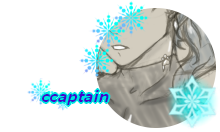
' You are not a primitive person by any means, but your mouth waters. It's an easy prey. You imagine the cooked meat roasting in its own grease... perhaps you have some spices in your traveling bag, some salt. You think the poor animal will make a fine meal, and so you strike it down and do as you thought, the meat juicy and tender. You feel your energies being restored bite after bite. You pick the bones clean. Somehow, this is one of the best meals you ever had.
You sit with your belly full of delicious rabbit meat, watching the bones, discarded skin and organs in the dying embers of your bonfire. You think leftovers of those, and you make the mistake of not honoring the animal that had to die to give you some energy to walk further distance.
With the parts of the animal that you have discarded, you should gather. With your bare hands, you should dig a hole deep enough by the roots of a nearby tree and rest what you call leftovers in it, to allow a tree to grow, from the substances that come from the decay of a life. Do it with your hands, devoid of gloves- let the grease and blood stain them to pay an higher price, show that you are not afraid of this form of respect. Put the organs and the bones you picked clean in the fresh grave you just dug, and cover it up. By doing this, you have given the appropriate respect to an animal who perished to sate your hunger- and you return what's left of it to the soil, feeding the roots of an hungry tree. You repay your debt to nature in kind, and you are free to go.
But you don't know, ignorant one that followed hunger. In your sated state, in your arrogance, you don't show the required respect. You leave what you arrogantly call leftovers in the dead embers of your fire, and arrogantly go on with your adventure.
But I can almost hear you think, hearing my story: ha! A dozen cute, fluffy bunnies to avenge their dead, fluffy kin? What will they do! Smother me to death?, and you'd be ignorant thrice not to think about the blood red eyes, the strong, long back and forelegs, about sharp teeth able to tear fingers out.
Staring at you in the darkness. Surrounding you like a pack of wolves, the hares have come for vengeance.
For your disrespect, you will become nothing more than the echo of agonizing screams some other traveler will hear at night. An echo passing in the wind, your bones unburied, everything about you consumed. Nothing left to waste.
Not even leftovers will remain of you. And all because you thought of yourself too highly, too arrogant to bury the bones of your meal. '
#riddle me this; is everything that you remember real and nothing but the pure truth? ━ (H:SR V.)#this is one of his tales and a lesson btw. imagine him telling this tale with his voice low and menacing. id shit myself#animal death ;;#gore ment ;;#ask to tag ;;#unsanitary ;;#i lowkey cooked with this ngl. will reblog it a couple times if i feel like it
5 notes
·
View notes
Text
Jean-Michel Basquiat is a Beacon in the East Village Art Scene
In the dimly lit alleys and bohemian lofts of New York City's East Village, a vibrant art revolution was brewing in the late 1970s. At its forefront stood a young prodigy, Jean-Michel Basquiat, whose meteoric rise to fame would leave an indelible mark on the art world. His raw talent, coupled with an unyielding spirit of creativity, propelled him from obscurity to prominence, earning him a place among the most celebrated artists of the 20th century.
Born in Brooklyn in 1960, Jean-Michel Basquiat journey to artistic acclaim was as unconventional as his work itself. Raised in a melting pot of cultures and influences, he soaked up the dynamic energy of the city streets, which would later become the canvas for his bold expressions. With a father of Haitian descent and a Puerto Rican mother, Basquiat's heritage infused his art with a rich tapestry of symbolism and identity.
In the late 1970s, the East Village emerged as a hotbed of artistic experimentation, attracting a diverse community of avant-garde creators seeking refuge from the commercialized art world. Basquiat found his sanctuary amidst this eclectic milieu, where he honed his craft alongside fellow visionaries such as Keith Haring and Jean-Michel's close friend and collaborator, Andy Warhol.
Basquiat's art defied categorization, blending elements of street graffiti, neo-expressionism, and primitive art into a singular, visceral style. His canvases pulsated with frenetic energy, adorned with enigmatic symbols, cryptic texts, and fragmented figures that spoke to the chaos of urban life and the complexities of the human condition. Each brushstroke seemed to echo the rhythm of the city, capturing its raw vitality and relentless pace.
It was not long before Basquiat's work caught the attention of the art world's elite. His first solo exhibition in 1981 at the Annina Nosei Gallery catapulted him into the spotlight, garnering widespread acclaim for his provocative compositions and fearless approach. Critics hailed him as a visionary, while collectors clamored to acquire his pieces, propelling Basquiat from struggling artist to cultural icon virtually overnight.
Central to Basquiat's appeal was his ability to bridge the gap between high and low culture, drawing inspiration from sources as diverse as jazz, street art, African masks, and classical mythology. His paintings spoke to the universal human experience, transcending boundaries of race, class, and gender to resonate with audiences around the world. In a society marked by division and discord, Basquiat's art served as a unifying force, offering glimpses of beauty and truth amidst the chaos.
Despite his meteoric rise, Basquiat remained fiercely independent, resisting attempts to commodify or co-opt his work for commercial gain. He rejected the trappings of fame, preferring to immerse himself in the creative process rather than bask in the limelight. His dedication to authenticity and integrity earned him the respect of his peers and secured his legacy as a true pioneer of contemporary art.
Tragically, Basquiat's life was cut short at the age of 27, succumbing to a heroin overdose in 1988. Yet, his influence endures, his legacy immortalized in the timeless brilliance of his art. Today, Basquiat's paintings command record prices at auction houses, his name synonymous with innovation and rebellion in the annals of art history.
In the decades since his passing, Basquiat's impact on the East Village art scene and beyond has only deepened, inspiring successive generations of artists to push the boundaries of creativity and challenge the status quo. His spirit lives on in the vibrant streets of New York City, where his presence is felt in every splash of color, every scrawl of graffiti, and every beat of the city's pulse. Jean-Michel Basquiat may have risen swiftly to fame, but his legacy will endure for generations to come, a testament to the enduring power of art to shape our world and ignite our imagination.
2 notes
·
View notes
Photo
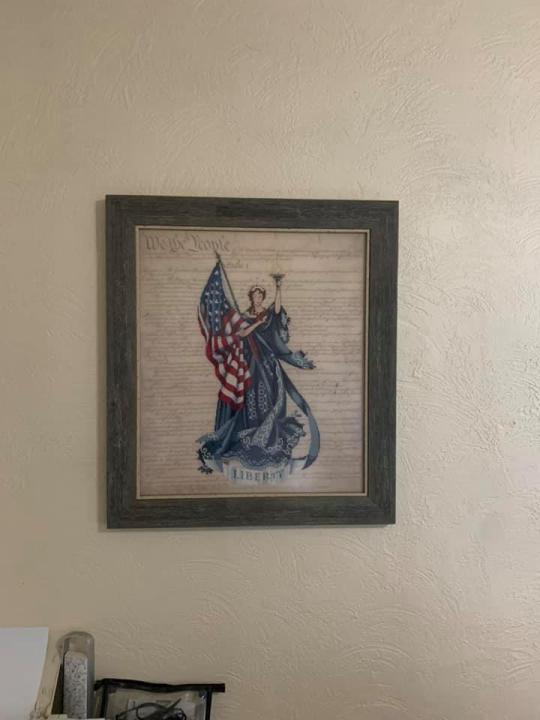



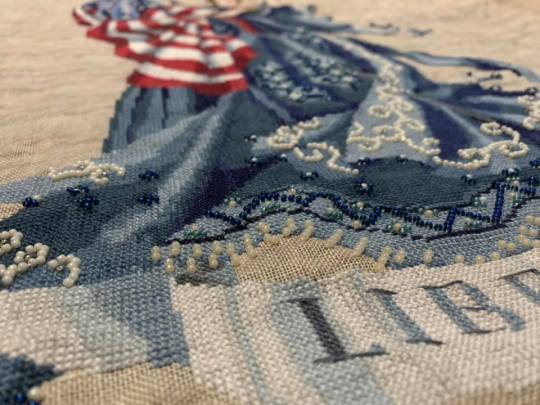
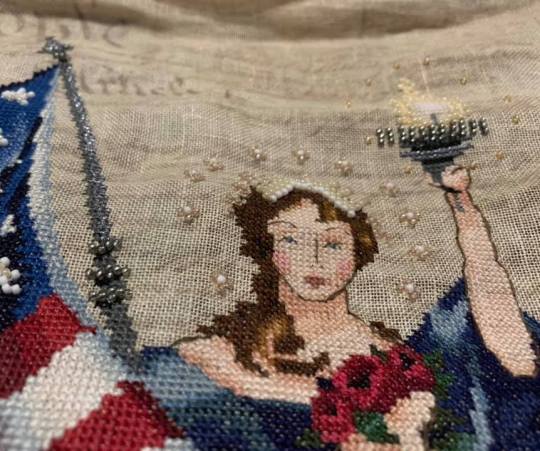
Mirabilia Designs #62: The Lady of the Flag stitched by Elizabeth Porter Duke. Pattern designed by Nora Corbett.
“Framed by Courtney-Laughlin framers in Beaver PA. Fabric by Primitive Hare on Etsy. Blue dress and brown hair conversions from the files, my own conversion along the bottom of the dress to take out the leaves.
I used Marsha Carlsen’s color conversion for the beads but I didn’t use them in the same areas. Where she had dark beads I used white ones.”
3 notes
·
View notes
Text
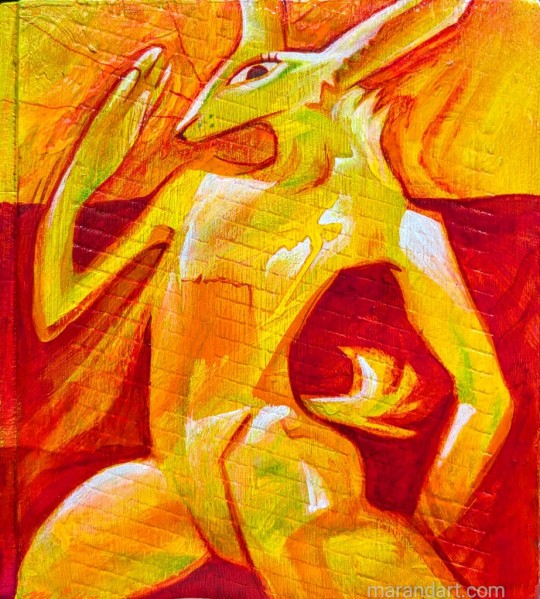
"Sprint Hare" 7.5"x8.5" acrylic and colored pencil on reclaimed wood
#art#traditional art#animal art#mixed media#acrylic#painting#primitive wiggles#anthropomorphic#naive art#hare
297 notes
·
View notes
Text
To Wish upon a Star
“Welcome home, my darling husband. How was your excursion?”
“It was well, my dear wife. You are awfully chipper today.”
“That’s because I bear exciting news. But first, tell me my darling, how are our children?”
“They are steadily returning to their ways. Their hearts yet sting with the tragedy that befell them five years prior, but many have once again gathered themselves to seek a new horizon. Regrettably, the one lost in time is not among them.”
“My my, so you haven’t noticed. I don’t blame you, however. Had I not witnessed his rebirth with my own very eyes, I would have assumed he was a little fawn as any.”
“Rebirth, you say? Wasn’t the sage’s magic supposed to protect him from—”
“My darling, it is unlike what you have in mind. No harm had come to him, but he was, without a doubt, reborn, rather than return. Perhaps it would be quicker for you to see him yourself. There, in the forest of Nophica’s.”
“...The magic he wears, he is undoubtedly her champion. Why has his form changed?”
“I have a theory, yet without a soulgazer, I can neither confirm nor deny it. I asked my sister about it, but that part of her memories had long faded through time.”
“...”
“What are you thinking of, my darling husband?”
“Your child. He seems… clueless. I’m afraid you calling him a newborn fawn may not be very far from the truth. My dear wife, in full knowing that it would break our sacred vow, I ask you to turn a blind eye to my upcoming indiscretion. Just this once.”
“Hehe. It wouldn’t be you otherwise. For one night only, my light will not reach him.”
******
Rumors of a beast wearing man’s skin lurking in the darkest part of the Black Woods has been running rampant these past three moons. Poachers, wood wailers and adventurers alike are less inclined to travel alone. Some groups are actively hunting it, even if no official bounty has been placed on its head.
This places the [beast] in question in a difficult situation. Primitive though his mind may be, he can still parse the concept of [cause] and [effect]. That the more people he attacks, the larger their number will become. But he can't leave them alone, either. Early on, he bitterly learns that meat tastes a great deal less pleasant without the fire and spices of the human camps. Much so that there have been days where he would go without anything in his stomach until he could “borrow” someone’s settings.
His stomach growls. He decides that he will fight a whole army tonight if he has to.
Fortunately for the elezen, the moon is completely covered, and the wood is eerily quiet. He had already caught a hare when the sun was still up, in case whoever he encounters next is short on supply. All he needs now is a light.
Just as he has hoped, in the corner of his eyes, a lamp swerves. Even better, it is heading his way. So he patiently waits. When the feeble ball of fire finally illuminates the stumps and branches, the elezen sends an arrow right next to the prey’s feet—a technique he quickly learnt from his first ever victim. This one, too, stops in his path. A short man with reddish brown hair, and no weapons in sight, not even a stick to perform magic with.
This should be easy.
The elezen slowly walks out from his hiding spot with a pointy pole—another item he looted from before—and looks dagger at the hyur.
“Are you the rumored [beast]?”, the man said with unexpected calm. He raises both his arms, hoping to convey that he meant no harm.
The elezen ignores all that as he lifts the pointy end of his pole ever closer to the other’s face. He gestures toward the oil lamp. The target is confused, but he yields it nonetheless.
Having obtained what he needs, the elezen sees no use for further intimidation, so he turns to look around for dead branches and leaves. After he’s done with the preparation, he throws the thing into the pile and lets the fire spread.
“Could it be that… you don’t know how to make a fire?”
Apparently, the hyur wasn’t scared away. The elezen keeps silent, then proceeds to take the hare meat out of his (once again, claimed from elsewhere) sack and shoving it through an arrow, grilling it on the open fire.
“I can show you how. It’s more reliable than hunting people at night, I promise.”
The muted man finally looks up.
“Interested, aren’t you? But first, may I have permission to set up a camp here? I lost my only source of light, after all.”
******
“There we go. Simple, isn’t it?”
It was not. Their little lesson almost cost the elezen his dinner. Luckily, the half not making direct contact with the fire is still edible. But all the smoke he inhaled from his previous attempts, along with his swollen fingers, is making the meal less and less appetizing.
As he is considering threatening some water out of the other man, a cup of sparkling liquid is readily offered to him.
“All you gotta do is ask. If you can’t find the words, use gentle gestures.” The brunette smiles at him.
With both hands, the elezen clumsily receives the beverage. It tastes sweet and sour at the same time. He winces a little at the new sensation, but quickly asks for more.
“Haha, you like it? It’s grape punch. Made from the freshest harvest in Wineport. You wouldn’t find anything like it here. Not from the rivers or the local population anyway.”
They both sit there quietly for a while, save for the sound of a hungry man’s munching, and the cackling of the fire.
Unpromptedly, the hyur asks:
“Do you have a name? People call you a [beast], but you don’t seem like one to me. If anything, you’re more of a wild child. The people you met must have treated you unkindly.”
There is truth to that. The [beast]’s first encounter with a human was a negative one. But he didn’t need to do what he did, either. He didn’t need to perpetuate it.
“In my experience, though, people aren’t all bad. They can be aggressive and dangerous, but they can be compassionate and protective, too. I myself am the type who prefers traveling alone. Even so, from time to time, I found immense joy in the brief companies I had along the way. Such as this moment.”
To that, the elezen ceases his hauling. He turns his gaze toward the veteran vagabond, with an expression a mixture of inquisition and yearning.
Tell me more.
What’s out there?
Where do I find it?
“I am but one man. My perspective is limited. To truly grasp the truth of this world, you must see it through many different views. That is a task a self-serving man like myself cannot hope to accomplish. In you, however, I sense strength, boundless love and unwavering bravery. You can achieve feats of glory never written in the history of our kind. All you need is the right people along the way.” The hyur then points to the sky. “If you don’t know where to start, wish upon the stars.”
“...Wish?”
It stuns the hyur a little. The muted man has spoken at last. He wonders if this is how it feels to hear your child’s first word. And for it to be a beautiful one, too.
“Yes. Same as us, each of their twinkle is a silent cry. [Look at me. I am here.] they say, amidst the cold and dark universe. An old acquaintance of mine often used that power to rally the stars to their aid. If the light in your heart is as bright as them, which I believe that it is, you may even find the force to triumph over the night, hotter and whiter than our little campfire ever could.”
“Wish…” the elezen whispers again.
Almost there, the other thinks.
“There are many ways to make wishes, but I find it most soothing like this.” He walks behind the elezen and leads the boney, slender hand to the flat, malnourished chest. Through it, he can feel a heart resonating strongly. “Close your eyes, my friend. Let this realm and those beyond hear your call, feel your soul and ponder upon your existence. Look for those who can guide you on your destiny, for I cannot stay past this night. If fate permits it, our paths will cross again. But for now, this is the end. May you ever walk in the light of the crystal.”

******
The next time the elezen opens his eyes, the sun is already shining warmly above him. He’s surprised that not only his belongings remain intact, but he was also gifted with extra luxuries. It seems like the stranger from the night before had diligently put out the fire, and caringly wrapped his unconscious body in a warm blanket. He also finds a bag filled with some extra clean clothes, a hefty amount of gold-coated metal, and a strange drawing. He is yet to understand the use of these items. However
“All I gotta do is ask.”
1 note
·
View note
Text
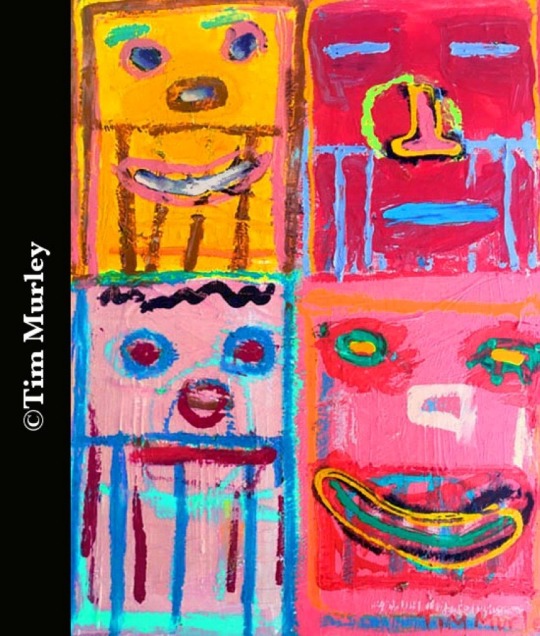
The new tenants. 🏙🌃🟧🟨🟥(mixed media collage)🏢
#de kooning#pablo picasso#picasso#basquiat#jean michel basquiat#art brut#naive art#primitive art#keith haring#outsider art#folk art#abstract face#pop art#andy warhol#rent#real estate#apartment buildings#urban planning#public housing#tenant#tenants#collage art#contemporary art#street art#bronx#williamsburg#staten island#oil stick#modern art#whitney museum
8 notes
·
View notes
Text

@hunt-the-hare sent ; “Do I get to skin you?” For evelaena from Remmick

evelaena thought she’d known fear living with the o’driscolls, but everything she’d felt with them paled in comparison to this. it’s a primitive kind of fear that makes her heart pound and her palms sweat. she is the rabbit caught in the hunter's snare before a wolf. the lamb away from the safety of its flock and its shepherd, with no way back into the arms of safety. she cannot help but wonder what she has done to be deserving of such torment. was it the things she's done to survive?
"please. . ." the word bubbles up in a mix of nervous laughter and a sob. it's not the first time she's had to beg for her life, but the fear makes it feel as if it might be the last. her words are her only defence, they always have been until this moment where everything she's ever learned in her life seems to leave her mind. but fear will do that to a person, won't it?
it wasn't as if she had meant for those o'driscoll boys to find her in town, to chase her out into the woods and a tangle of vines that led her into an old hunter's trap, forgotten at some point from the look of it. she'd expected those o'driscoll's to come crashing through the treeline, not this . . . man. had he killed them all or would he become another of their victims too?

"this isn't the time for jokes," she tries to keep her voice light, keep the fear she feels out of it, but he doesn't strike her as the type to joke about such a thing. "i need . . . i need help, please." oh, how she hates to beg, to be at this strangers mercy, but what choice does she have now? she'd do what she must to make it out of this alive. she always has.
#hunt-the-hare#evelaena szarr; interactions#evelaena szarr; verses & red dead redemption 2#this is meh don't boo me too hard
1 note
·
View note
Text
1975- U15
14/4/25
15/14
NIGHT IN BETLA
It comes to me like a hunger that longing
For susurrations of night in the plateau forest
Where the shimmering wings of night insects
Mimic the twinkling of stars above the tree canopy
And the winking of fish in the glimmering river
And the seven streams gleaming singing softly to themselves
As they slither with serpents through thick undergrowth
Nothing loath to join the flow of River Koel
Like a lullaby to sleeping elephants and bears
And hares too tired to leap now resting
Beneath the teak trees where birds are nesting
Monkey mamas grumbling when babies wake up
Predators lurk near the caves and the waves
Near cascades tumbling and rumbling in falls
When bat wings flap and sleepy mice are scooped
And the swoosh and the hoots of the night owls disturb
The wolves baying eerily to the pink moon
Their silver pelts lit by the moonrays straying
Where their lairs lie. The coiled python sleeps
In its earthen nest longing for rest
Digesting its meal in visible bumps
Slowly sliding down its rolled dappled length
So lazy you’re tricked into doubting its strength
Which can grip you and squeeze you to death.
Breath longs to smell
That damp green refreshing ferny forest scent, heaven- sent.
Shinrin Yoku they call it- forest bathing
This midnight greening in a lush-leafed darkness
And barking deer leery of tigers and jackals
Sibilant breezes bringing on the dawn
Peach pink and absurdly pretty amid all
This primitive beauty. Peacocks pirouetting
Parrots peeking and pecking at palaash flowers
Resembling their beaks. White lotus blooming
On Kamaldah lake. To wake up to this.
Herds of bison moving noisily towards grassier bliss. Sal flowering, showering blossom
On jungle’s bosom. To wake up to this bliss.
Then sink back to sleep some more, sinfully, lazily,
Luxuriating on banks of silky sal leaves
Till the sun rises stronger.
( ASA )
0 notes
Text
"I'LL FOUND YOU, I'LL ALWAYS DO"

Another story with Sergei, cause I love him so much (and I need him so bad) 😭
I hope you like it!
Megan knew he was there, in the shadows.
She couldn't see him, nor could she hear his footsteps. Her father had taught her well. The way he glided over the grass gave it away, with the stealth of a panther and the speed of a hare.
She hid behind a tree, careful not to step on any branches, because doing so would let him know where she was.
What she didn't know was that he had already seen her. He had her in his sights. Perched on some branches a couple of trees away, he watched as she tilted her head to look left and right, covering both sides.
"If only she knew I was on top of her" he thought as an amused smile formed on his lips. He focused all his attention on his girl, evaluating her movements.
How nice it felt to say it, "his girl" because that's what she was. He loved her above all things. He loved playing cat and mouse with her. Doing so brought out her most primitive side.
As if he were a hungry lion and she a defenseless sheep waiting to be devoured between his powerful fangs.
He noticed how her chest rose and fell rapidly, her labored breathing denoted one thing: she was very excited. The hunter tried not to think about the moisture that was surely between her thighs, if he did that game would end too soon.
She was enjoying it too much for it to end so abruptly.
"I know you're here somewhere, Sergei," she shouted, turning around. "Are you tired of playing?" she asked, the hunter's smile widened.
He loved it when she challenged him like that.
"This has only just begun, darling," he whispered, moving through the branches, getting closer and closer to where she was.
She looked up when she heard the sound of leaves clashing against each other. Still, she couldn't see him, he was moving too fast for her eyes to see.
She felt a movement above her head and didn't think twice: she started running. From time to time she looked back to see if he was coming after her, but all she could see were the distant lights of the city that she left behind with each stride she took.
"You won't be able to escape from me forever," he let her know, she continued running, trying to hide from him. "Look at you, my scared little fawn," he growled, making her skin crawl all over, the pressure in her lower belly was starting to be unbearable. "Running away from me…" he stammered. "I'm going to hunt you," he assured her, "and when I do…" his hoarse laugh filled the air. "I won't let you go."
She continued running a little further until she hid behind a tree again. Her breathing was labored both by the excitement she felt, and by the run. Although it was more because of the former.
She strained her ears trying to hear some sound that would reveal where he was. A few approaching steps were enough to know that he had come out of his hiding place, and was slowly approaching her position.
"It's useless for you to hide," he whispered. "I'll find you, I always do," he said. "Your body gives you away, darling," he let her know, making her press her back closer to the trunk to hide better. "I can hear the accelerated beats of your heart under your skin slippery with sweat." Another pair of steps echoed in a place to her left. "Are you like this for me, little one?"
"You know I am," she replied, unable to remain silent for a second longer.
It was then that she brought her hand to her mouth, realizing what she had done. She had revealed her position. A draft stirred the leaves on the ground in front of her, making her close her eyes. When she opened them again, Sergei's amber eyes were watching her intently, a smile of victory adorning his lips.
"I found you," he celebrated, approaching her with the slowness of a predator.
"So, will you keep your promise and not let me go?" she asked. He smiled and cornered her against the tree, while outlining the curve of her lower lip with his index finger.
"You know I do," he whispered, softly kissing her lips. "I always keep my promises."
0 notes